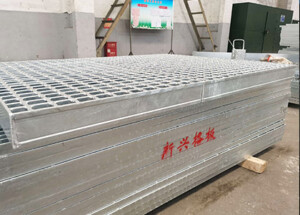Steel grating and riveted grating are two common types of grating used in various industrial and commercial applications. Kedua-dua jenis jeriji mempunyai ciri dan kelebihan unik mereka sendiri, making them suitable for different purposes.
Grating keluli diperbuat daripada bar keluli yang dikimpal bersama untuk membentuk corak grid. This type of grating is known for its high strength and durability, making it ideal for heavy-duty applications such as industrial flooring, Laluan catwalk, dan tapak tangga. Reka bentuk terbuka Grating keluli allows for the passage of light, atau dikimpal sepenuhnya oleh bar rata, and liquids, making it suitable for drainage and ventilation purposes.

Sebaliknya, riveted grating is constructed by riveting bearing bars and cross bars with rivets. This type of grating offers excellent lateral stability and can support heavy loads. Riveted grating is commonly used in bridge decks, pelantar kayu dan penutup tanah simen, and platforms where high strength and safety are required.
When comparing steel grating vs. riveted grating, it’s important to consider factors such as load capacity, deflection, open area, and overall cost. Kisi keluli typically has a higher load capacity and lower deflection compared to riveted grating, making it suitable for applications where heavy loads need to be supported. Walau bagaimanapun, riveted grating provides greater lateral stability and is often preferred for its aesthetic appeal and architectural design.
In terms of open area, steel grating offers better visibility and airflow due to its open grid design. This makes it a popular choice for applications where light transmission and ventilation are important. Sebaliknya, riveted grating provides a solid surface with minimal open area, making it suitable for areas where small objects need to be retained or where a flat walking surface is required.
Cost is also an important factor to consider when choosing between steel grating and riveted grating. While steel grating may have a higher initial cost, it often proves to be more cost-effective in the long run due to its durability and low maintenance requirements. Riveted grating, sebaliknya, may require more frequent maintenance and replacement, leading to higher long-term costs.

Kesimpulannya, both Grating keluli and riveted grating have their own unique strengths and weaknesses. The choice between the two types of grating ultimately depends on the specific requirements of the application, including load capacity, deflection, open area, and cost. By carefully evaluating these factors, it is possible to determine the most suitable grating solution for a wide range of industrial and commercial applications.

